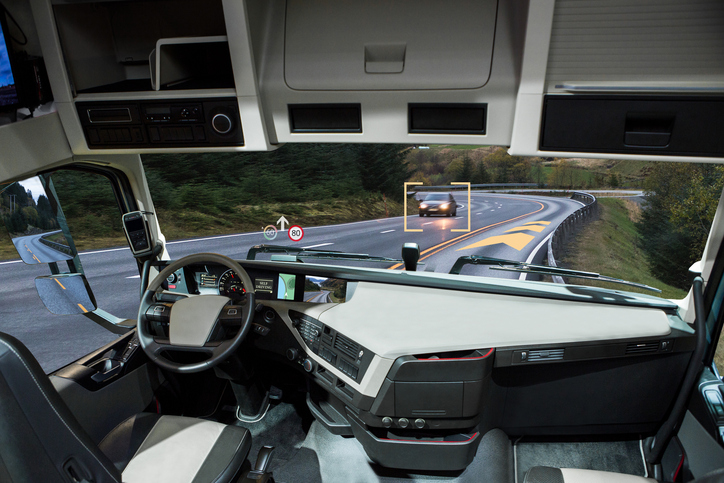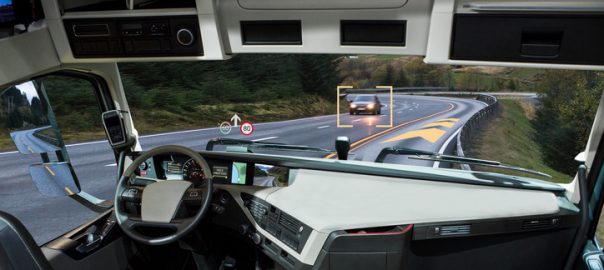A boy stares out his window, with his nose pressed against the glass as the big rig pulls closer to his family’s car.  He pauses, ready to signal the driver to blow the horn as soon as it comes into view. As the semi moves past him, his eyes widen, and his mouth drops open. There is no driver behind the wheel!
He pauses, ready to signal the driver to blow the horn as soon as it comes into view. As the semi moves past him, his eyes widen, and his mouth drops open. There is no driver behind the wheel!
This sounds like a science fiction scene set 50 years in the future, but some experts are predicting that driverless trucks could be on American highways within the next decade. Otto co-founder Ron Lior is among one of these experts. Otto exists to create self-driving freight trucks. Uber, a popular ride-sharing company, acquired Otto in August of 2016, less than a year after its inception. Ron recently shared his thoughts at an Artificial Intelligence (AI) conference conducted by the MIT Technology Review. His vision includes routine deliveries by self-driven vehicles within the next 10 years.
Not everyone shares Ron’s enthusiasm for vehicles driven by artificial intelligence. Many truck drivers are wondering if technological advances will render them obsolete. In an industry already experiencing personnel shortages, the possibility of being replaced by a computer does not encourage growth. Looking at the effect of technology in the transportation trucking industry can help paint a clearer picture of what to expect in the future.
How Do Tech Advances Impact Freight Brokerage?
Improvements in technology have created both positive and negative changes within freight brokerage and transportation. For instance, cloud-based technology levels the playing field for small brokerages. Billion-dollar companies may make more than smaller firms, but break it down into revenue generated per employee, and you get different pictures of success. The most successful large firms generate about $700,000 to $1 million per employee. The most successful small brokerages produce about $1 – 3 million per employee.
Technology Improves Transportation Management Process
Technology is also responsible for improvements in transportation management. The correct software streamlines the process of finding and contracting loads. It also tracks and documents each step of the delivery, saving valuable time in the process.
Uber Freight is one of these developments. The app allows vetted drivers to schedule loads with a single click. Confirmation for the load takes just a few seconds instead of hours. Drivers who book loads through Uber Freight may receive pay faster and receive pay for any delays. When a truck driver needs to return home, the ‘Take Me Home’ feature on the app helps book a load headed toward their destination. This piece of technology gives small shippers and independent owner-operators an edge they need to continue doing business.
Not All Tech is Good for Truckers
However, other technological advancements threaten the livelihood of some truckers. Amazon Prime Air may be good for the company’s bottom line, but it can reduce available freight for truckers. The drone delivery service aims to deliver packages within half an hour of the customer’s click. Speed and novelty are both aspects of the appeal of drone delivery.
The program is not quite up and running just yet. Amazon tested the first drone delivery in the UK on December 7, 2016. The first American drone delivery took place in March at an invite-only tech conference. As of now, there are still several kinks to work out. Weather, weight, and airspace access all factor into the program’s viability.
Continued Need for Human Intelligence
There are also limits as to what Amazon’s drone delivery service can do. The machines cannot deliver packages that weigh more than five pounds. High winds, sleet, and heavy rain also keep drones on the ground. Under these conditions, human drivers are still necessary to complete these deliveries. If the drone AI has limits, perhaps self-driving trucks do too.
Although, Ron predicts that driverless trucks will be a normal part of the trucking industry within the next decade, he also sees the AI driving systems as an assistive technology rather than a complete replacement for human drivers. For the “foreseeable future,” he says, AI systems would act as a “co-pilot” rather than taking over driving completely.
Smart Systems Still Need Human Navigators
For instance, it is much easier for AI software to navigate long stretches of highway where speeds are consistent, and there are few stops. City traffic is much more complicated, requiring a human driver to make complex judgment calls.
It is worth noting that Otto’s parent company, Uber, is working to develop smaller vehicles that could navigate city streets using AI software. Successful implementation of this technology could in fact threaten human driving jobs. However, Uber suspended testing on self-driving vehicles in March after one car collided with a vehicle that failed to yield to the AI-driven SUV. The collision ended with the autonomous vehicle landing on its side. That being said, autonomous technology may not be successful.
Imagining the Future
The addition of an AI co-pilot could also affect transportation regulations. It is interesting to imagine a future in which the driver sleeps while the system navigates highway miles, then wakes to finish delivery within the city. With that in mind, it is still difficult to determine whether AI-driven trucks would be beneficial or harmful to truck drivers.
As a species, we have made more technological advances in the past 100 years than we managed to in the previous 1,000. Change is inevitable, and it will take adaptation to move forward. Truck drivers who are willing to grow and learn can use these technology trends to their advantage. In the meantime, hang onto your job. There are still plenty of things humans can do that machines cannot.


